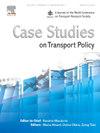Identifying distracted driving hotspots using an event-to-crash conversion method: a case study from New Jersey
IF 3.3
Q3 TRANSPORTATION
引用次数: 0
Abstract
Identifying crash hotspots is a tool for prioritizing safety countermeasures. However, safety–critical human factors like distracted driving or speeding can often happen without leading to a crash. Hence, a matrix is needed that could translate the contributing safety–critical events into crashes. Quantifying distraction events into crashes could bridge this gap, and comprehensive observational data on drivers’ distractions could help make this quantification. This study aims to build a framework for calculating the relationship between crashes and events by collecting distraction events in selected high crash corridors in New Jersey. On-road observational data was collected to capture distracted driving behaviors using a moving test vehicle. Crashes occurring at the study routes during 2015–2019, with ’distraction’ as the only ’driver contributing factor,’ were collected. Afterward, the distraction event-to-crash ratio was calculated for each 5-mile road segment, which helped determine the study routes’ riskiest segments (hotspots). After converting crashes to events, the potential crash cost savings for various levels of reduction in distraction events (5%, 10%, 20%, and 30%) were calculated. The results revealed that US9, US1, US22, and US130 were the riskier corridors, with at least one crash from every 30,000 distraction events. It was also found that roads with signalized intersections, three-lane roads, rural interstates, minor arterials, and positive medians had the highest number of hotspots. Non-parametric tests confirmed that arterial roads and roads with signalized intersections have significantly lower event-to-crash equivalence than the other types of roads. This study will help state and local agencies identify distracted driving hotspots in their jurisdiction and enable them to allocate resources for education, enforcement, or engineering solutions more efficiently.
使用事件-碰撞转换方法识别分心驾驶热点:来自新泽西州的案例研究
识别碰撞热点是优先考虑安全对策的工具。然而,对安全至关重要的人为因素,如分心驾驶或超速驾驶,往往不会导致撞车。因此,需要一个矩阵来将安全关键事件转化为崩溃。将分心事件量化为车祸可以弥补这一差距,而对司机分心的全面观察数据可以帮助进行量化。本研究旨在通过收集新泽西州选定的高碰撞走廊的分心事件,建立一个计算碰撞与事件之间关系的框架。收集道路上的观察数据,利用移动的测试车辆捕捉分心驾驶行为。收集了2015-2019年期间在研究路线上发生的交通事故,其中“分心”是唯一的“司机因素”。之后,计算了每5英里路段的分心事件与碰撞比,这有助于确定研究路线上最危险的路段(热点)。在将碰撞转换为事件后,计算了不同程度的分心事件减少(5%,10%,20%和30%)的潜在碰撞成本节约。结果显示,US9、US1、US22和US130是更危险的走廊,每30000次分心事件中至少有一次坠毁。研究还发现,具有信号交叉口、三车道道路、农村州际公路、小主干道和正中路的道路热点数量最多。非参数测试证实,与其他类型的道路相比,主干道和有信号交叉口的道路的事件碰撞等效性明显较低。这项研究将帮助州和地方机构在其管辖范围内识别分心驾驶热点,使他们能够更有效地为教育、执法或工程解决方案分配资源。
本文章由计算机程序翻译,如有差异,请以英文原文为准。
求助全文
约1分钟内获得全文
求助全文

 求助内容:
求助内容: 应助结果提醒方式:
应助结果提醒方式:


